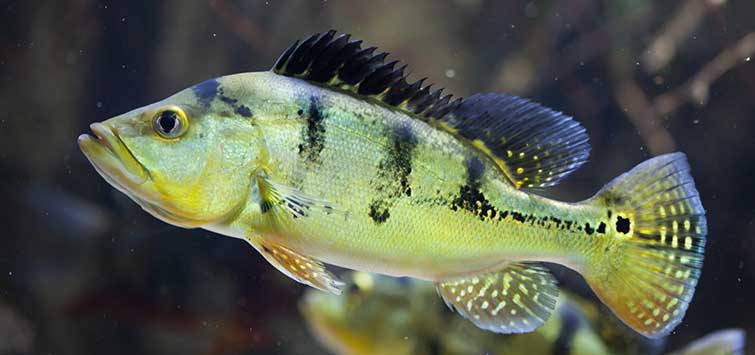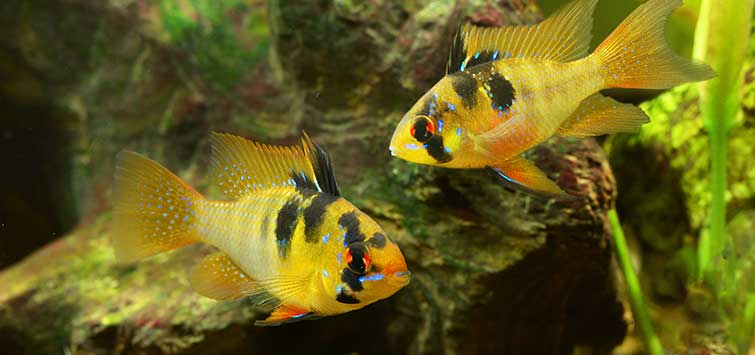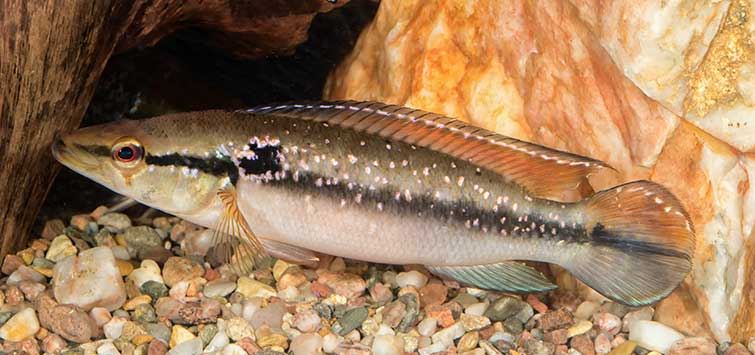A Cichla Saga
Author: Ric Perez
A tale of persistence and ultimate triumph; the author became the first in the United States—and one of the first in the world—to successfully breed Cichla sp. peacock bass.
This is a tale of persistence and trial and error. Not many people will keep trying to spawn a favorite fish for 20 years without success, but Ric’s tenacity finally made him the first aquarist in the United States—and one of the first in the world—to breed Cichla, and he has F2 fish in his impressive fishroom—Eds.
The Saga Begins
It all started in 1979. While visiting a pet shop I noticed a fish in one of the tanks. It was a silver fish with a black line. It was about 2 inches long and was eating some guppies. It had two guppies in its mouth facing different directions and was attempting to catch another one. I looked to see what the fish was, but it was just marked “peacock bass.” It was priced very reasonable so I bought three. I talked to the manager of the fish department at the store and they did not have much information on the fish.
Failing the First Attempt
I took my three new fish home and tried to feed them dried fish food and pellets, but I noticed that they would just take the food in their mouths and just spit it back out again. The fish got skinny quickly, so I bought more guppies. I noticed that they had ferocious appetites and grew extremely fast. Soon, picking up enough feeders to keep the fish full became a problem.
Two of them ate so much that the third seemed to never get any of the food. It wasn’t very long before the biggest one swallowed the smallest one. The fish graduated to eating goldfish in about a month. After about six months the fish were 6 or 7 inches long, and had a nice green color with orange fins and a black triangle on their tail. Around this time I got some feeder goldfish that had ich. As a result, both of my fish got it too, and when I tried to treat them with an ich medicine they died within 24 hours.
Giving It Another Go
I began looking for some more baby peacock bass, and about a year later in October I found them again. I bought six and put them in a 55-gallon tank. Like the others, these were about 2 inches long. I started feeding them feeder guppies, and they grew quickly again, up to about 5 or 6 inches. The fish were pretty close in size, and I had to feed them large amounts of live food. I started collecting minnows and small sunfish from a local pond to feed them. When the pond became unavailable due to snow and ice, I was forced to purchase feeder goldfish from the local pet shop.
During one of my trips to the store, I noticed that all the goldfish looked really sick, so I decided to switch to different types of food. I went to bait stores and picked up a box of nightcrawlers. My fish hadn’t eaten in almost two weeks, so they were due for a good feeding. However, when I tossed the nightcrawlers in they all devoured one but didn’t touch the others. A couple of days had to go by between feedings, and they would only eat one or two of the nightcrawlers.
One day when I came home I found two of the fish motionless on the bottom of the tank. The larger fish had one of his brothers stuck in his mouth, and both of them were dead. I was worried that something was going to happen to the rest, so I purchased some feeder goldfish. After about a week I noticed that the remaining four started rubbing and scratching themselves on the gravel in the tank. I knew they were coming down with ich again. I tried raising the temperature and adding salt, but it wasn’t long before the fish were completely covered with spots and breathing heavily. I treated them with some ich medicine at half dosage and woke up the next morning to find them all dead again.
Down but Not Out
I didn’t get any more peacock bass for a few years. Then while visiting a pet shop I noticed that they had some more peacock bass that were about 4 to 5 inches. They were a little pricey, but since I was a regular customer the pet shop owner sold them to me at a discount. I purchased six.
I ended up keeping this batch until they were about four or five years old and 10 to 12 inches long. At the time I knew nothing about water changes, so I only added fresh water as the tank evaporated or when the water got a deep yellow color. After trying repeatedly once again to find other food for these fish, I attempted to feed them dead fish from the supermarket. Just like the last batch did with the nightcrawlers, they would only take the first one after not eating for a long period of time. They got ich again and all died.
Eventually I became a member of the Greater Chicago Cichlid Association. A gentleman who was a friend of a friend from the club had four large peacock bass that he raised, feeding them only live fish. He was very tired of getting the live fish for the bass, so he was trying to get me to purchase them from him. He finally talked me into just coming out and taking a look at them. When I got there and saw these 20-inch beauties I just had to take them home. I purchased them from him and stuck them in a 225-gallon, 6-foot tank with a big pair of Parachromis managuensis (male 20 inches, female 14 inches).
After being in the tank for almost a year together, the pair of managuensis spawned and beat up the peacock bass. About a week later one of the peacock bass jumped out of the tank; I was left with two.
The Spawning Begins
The day before I was leaving for an American Cichlid Association (ACA) convention I noticed that the managuensis were pinned to the corner of the tank, and the male bass would not allow them to turn around. After further investigation, I noticed the female bass was fanning what looked like wrigglers at the bottom of the tank. I took pictures of the female bass over the eggs and brought them to show my fellow hobbyists at the ACA. Everybody was really excited.
I retuned home to find all of the fish swimming around the tank normally, and no baby bass were in sight. A few weeks later I noticed the managuensis in the corner again, with the female bass fanning eggs. The eggs were a deep yellow to gold color and were attached to little strings; it looked a bit like an anemone. I checked the eggs several times a day and noticed that they were turning dark and hatching. As soon as they were all hatched the female bass dug pits in the gravel and covered the babies in it. About a week later I noticed that the female bass was digging all over the tank trying to find her babies. I already knew what had happened to them; the tank had been infested with Malaysian burrowing snails.
Success!
Now I had to play the waiting game. I started doing larger water changes in the tank and feeding them larger and larger feeders. I think it was about six months later I began to notice pre-spawning play between the two bass. They were doing a lot of body slapping and challenging and bluffing each other by opening their mouths wide. After about a week, I went down to the basement early one morning and caught the female and male making passes over a large rock right next to each other. This time I waited a few days. When I saw the babies start to hatch I pulled the rock and stuck it in a 20-gallon tank with methylene blue and an airstone. The fry hatched and slid around the bottom of the tank for about four or five days.
Once the babies started coming up as a whole group, I began feeding them live baby brine shrimp. Because of my inability to be home during the day I was feeding them real heavy. I then noticed a lot of the baby fish were swimming improperly. After looking further, I determined that their tails had been burned off from the high ammonia that was a result of the uneaten brine shrimp in the tank. The fish were just as hungry as they always were, and they were cannibalistic toward each other. Most of the baby fish grew their tails back. About 1/3 of the fish had tails that were okay, and the tails on the rest were either pinched or crooked.
As the fry were growing I repeatedly tried to give them other foods to eat besides the live shrimp. I sold about 50 of the babies to different people and kept about 30 or 40 for myself. The fry that I kept went from baby brine to frozen brine. When they got to be about 3 inches long I noticed a lot of the babies were flashing again, and I knew they had ich. I was very fearful and attempted to use some ich medicine on them. I noticed a lot of baby fish on the bottom of the tank dead, and they were all fat. The ones that were still alive seemed to be eating things in the water that I couldn’t see when I was feeding them; I believe the babies died from eating the free-swimming ich—they didn’t seem to have enough spots on the outside to warrant dying.
Almost all the people that got the baby bass from me ended up losing them for different reasons. A friend of mine in Des Plaines was able to keep his alive in a 200-gallon tank. During the process of moving I threw some large pacus in the tank with the wild pair of peacock bass. I came home one day and found my peacock bass dead and the pacus barely alive. They had disrupted the filtration system and stopped it from working.
Dan Comes Through
When the F1 bass at Dan’s house were about five years old they had outgrown their 200-gallon tank so he built a big tank in his greenhouse that was 12 x 3 x 3 feet deep. When the water temperature in the greenhouse got up to about 90°F the bass started laying eggs. Dan called me up and told me he had eggs and that I should come pick them up. He had two pair in the tank, with an extra female. Both pairs laid eggs every three or four weeks. I kept raising the fry up to 1½ inches, starting them off on baby brine and then converting them to frozen brine shrimp. I lost about 30 different spawns to ich, only being able to raise a few babies at a time. The size of the spawns were between 800 and 1000 babies. I managed to raise about 15 F2s, giving half to Dan and keeping half for myself.
The F2s started to lay eggs at about 7 inches, with the water temperature about 82° to 84°F, and they are only about a year old. The Fls and F2s are eating dry fish food, large floating pellets, and the fish seem to be doing really well on that.

.png?h=595&iar=0&w=2781&hash=5FD5E69473BCC22199FBFA2FB71B6033)



